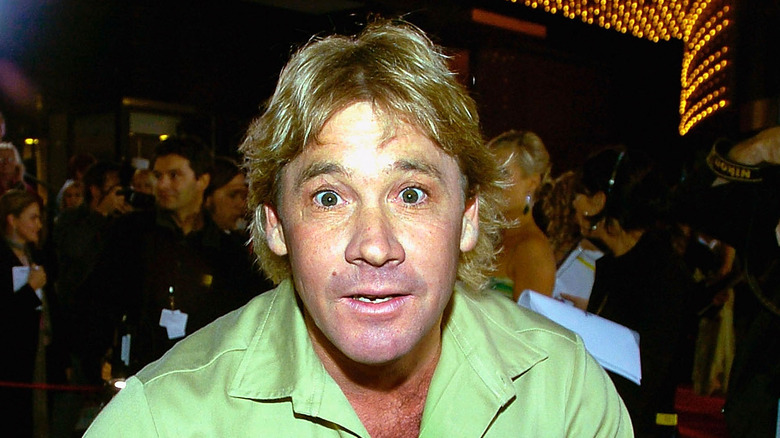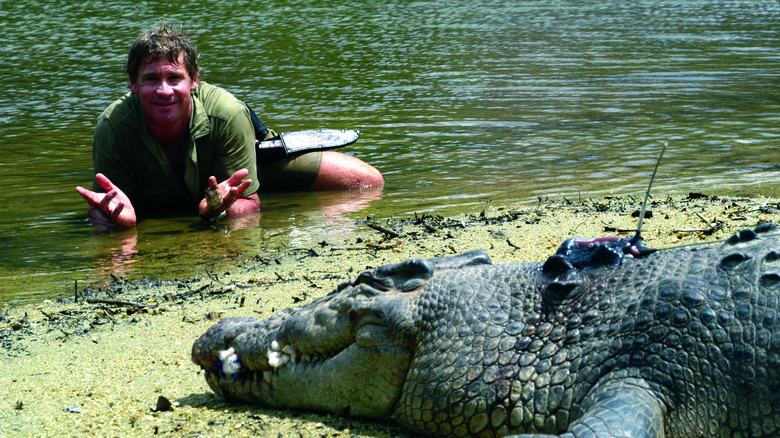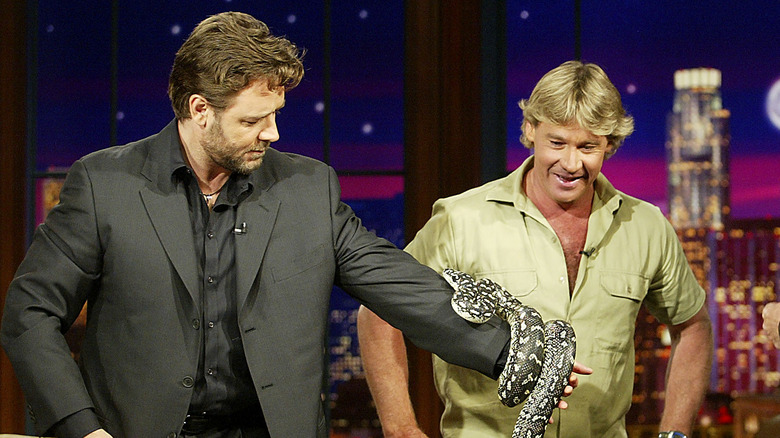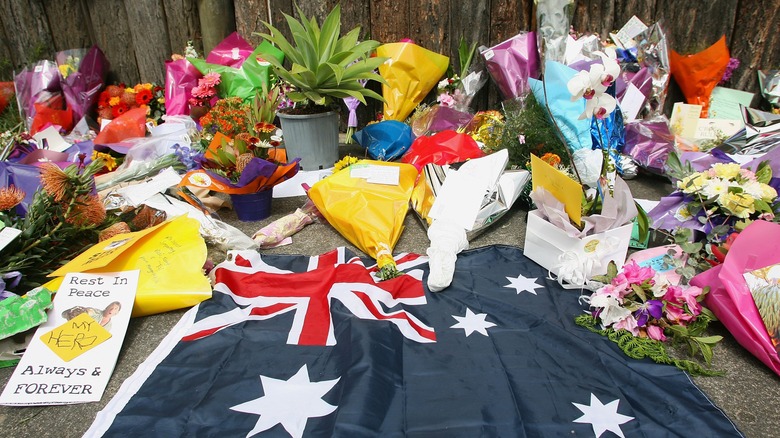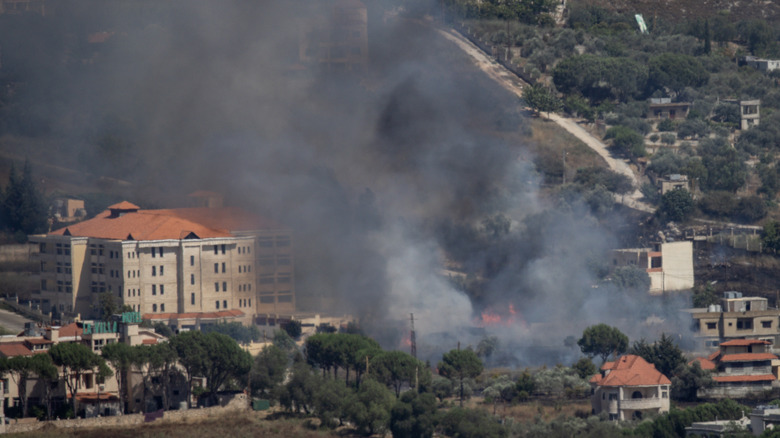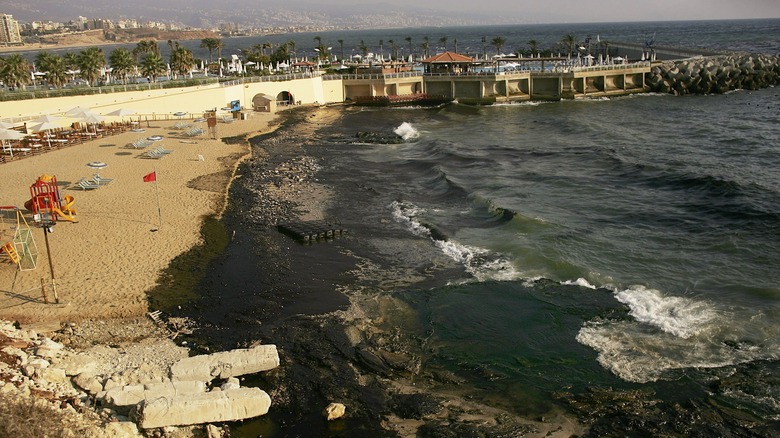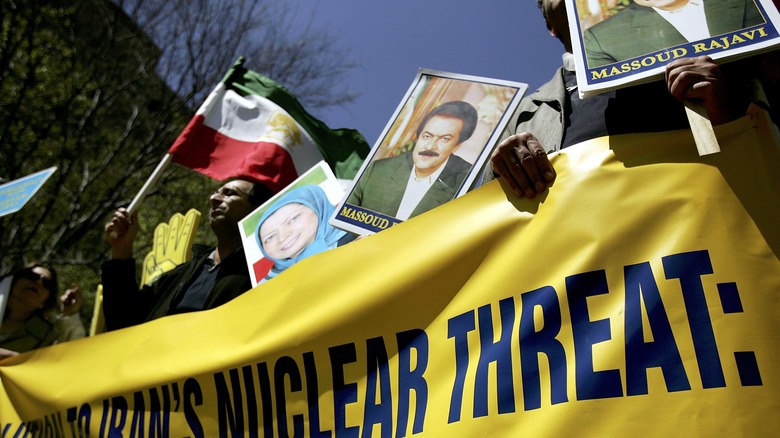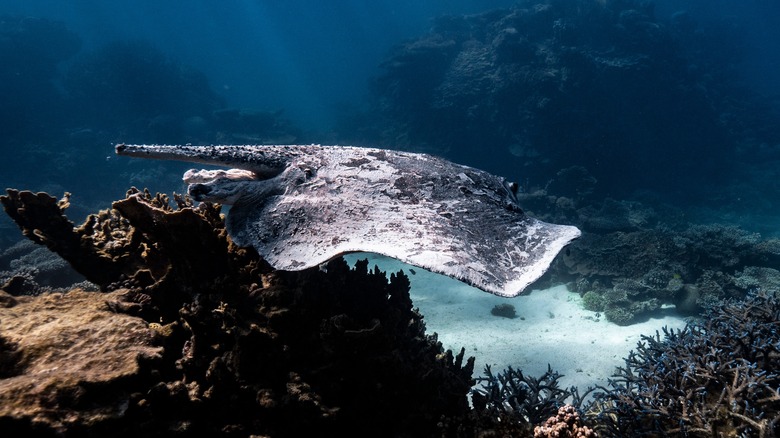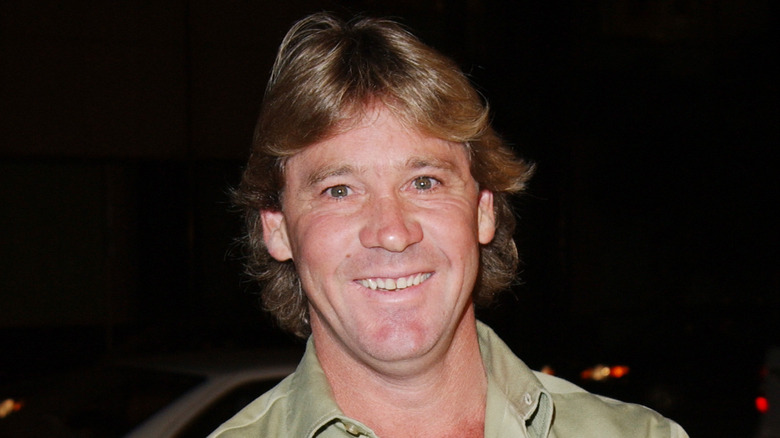What It Was Like The Day Steve Irwin Died
The one and only "Crocodile Hunter" Steve Irwin made a prominent career out of interacting with dangerous animals, rescuing them, and making documentaries of his various adventures. Irwin was a martial arts-training, nature-exploring wildman who genuinely loved animals, who once even discovered a new animal species during his many travels. Unfortunately, his career and life were cut short by the very thing he loved. Irwin died in a shocking stingray incident on September 4, 2006 — not long after laying out a 10-year plan for his Australia Zoo.
Irwin's death was a terrible event, but it was also just one of the many things that happened at this particular time in history. To get a better idea of what life was like when the tragic news of his passing arrived, let's take a look at how the events surrounding Irwin's death unfolded, and what else was going on in the world on that sad day.
Irwin was fatally stung by a stingray
The only animal Steve Irwin was afraid of was the parrot, due to numerous incidents where they bit him. However, the animal that actually took his life had a far more docile reputation. Stingrays are usually quite harmless, but on September 4, 2006, a rare incident involving one caused Irwin's death at the age of 44.
The zoologist was filming a documentary called "Ocean's Deadliest," a documentary about the dangerous sea life around the Great Barrier Reef. On September 4, the crew couldn't film as intended, so he took the opportunity to film some family-friendly material, with a stingray he found lounging in shallow water, for his eight-year-old daughter's youth-oriented series, "Bindi, the Jungle Girl." Unfortunately, he disturbed the animal, which reacted by stabbing Irwin in the chest with its stinger — a rare but highly dangerous injury. Irwin's heart had little chance, seeing as the stingray struck him right in the chest multiple times. At least one of the stings hit Irwin's heart, and in the aftermath, he expressed a belief that his lung had been pierced, as well. The combination of the agonizingly painful venom and the physical trauma proved fatal.
"It was just a really bad accident," toxinologist Jamie Seymour described the incident in an interview with WBUR. "If he'd been five feet one side or coming from another direction or the sun had been somewhere else, [the stingray's attack] wouldn't have happened."
The reactions to Irwin's death were immediate
News of Steve Irwin's death spread quickly on the afternoon of September 4, 2006, prompting sad and shocked reactions from many Australians — famous and regular alike. High-ranking politicians expressed genuine-sounding grief with glazed eyes. The media was awash with Irwin-talk, from tributes to discussion of his ambitious conservation plans and sympathy toward his family. Actor Russell Crowe, who was Irwin's friend and among the many who commented on the news that day, later revealed that even in the U.S., Irwin had dominated CNN's news cycle for an entire week. "There are not many zookeepers who would command that sort of attention," he said (via The Guardian). "And all that means is you got your message across."
The public was also quick to react to the tragic news, showing what a national icon Irwin had become in Australia. The relatively mundane animal that had killed the man who had survived some of the most dangerous beasts on the planet prompted disbelief. Australian expats in other countries headed to Aussie-themed bars to reminisce, and people were seen with black armbands and Irwin-themed mementos that ranged from wigs and fake crocodiles to replicas of his famed khaki uniform.
While Irwin was a divisive figure to some due to the occasional misstep, as well as the way he presented himself as an old-school Australian stereotype, even some detractors admitted that his conservation work had been admirable.
Irwin's Australia Zoo became a place of pilgrimage
Steve Irwin's home base was Australia Zoo, a vast wildlife park on Queensland's Sunshine Coast. Irwin's mother established it in 1970 as Beerwah Reptile Park, and Irwin's family later expanded it into a 700-acre conservation and education park with its own wildlife hospital and a staff of more than 500 people.
As soon as news of Irwin's death reached people's ears, the facility acquired a secondary purpose as a place of pilgrimage for fans who were mourning the loss of a national icon. So many people flocked to the area to leave flowers and pay their respects that it actually caused traffic problems, and the police in the area had to temporarily lower the speed limits to minimize risks.
The people who made the journey were on the right track in that Australia Zoo was likely the most important place in the world for Irwin. It went on to play a massive role in the aftermath of his death. Terri Irwin went on to announce that a televised public vigil for his husband would take place at the zoo's Crocoseum area, after deciding it was the only location Irwin would have approved. The event was ultimately watched by some 300 million people worldwide. The Australia Zoo is also Irwin's final resting place, as his family declined a grand state funeral and opted to privately bury Irwin at his beloved conservation park.
The Lebanon War had just ended
When Steve Irwin died, the world was dealing with the aftermath of the 2006 Lebanon War, which had ended on August 14. This conflict between Israel and the Hezbollah militia wasn't the first clash between the Lebanese group and the Israeli Defense Forces (IDF). However, things escalated to a full-on war on July 12, when the Hezbollah attacked Israel, killing eight Israeli soldiers and taking two as hostages. Israel responded with highly destructive bombings that destroyed numerous Hezbollah targets, along with a considerable amount of infrastructure in southern Lebanon and Beirut, while the Hezbollah orchestrated further rocket attacks.
Ten days into the war, the IDF started a land attack on Southern Lebanon, and on August 14, the United Nations got the conflicting parties to agree to a ceasefire that effectively ended the war in a draw. However, tensions remained, and Israel's aerial and naval blockades of Lebanon were still in effect at the time Irwin died.
Lebanon and Israel haven't exactly mended fences after the 2006 war, which killed over 1,260 soldiers and civilians, the vast majority of whom were Lebanese. In fact, the lingering tensions on the border seem to have escalated. In 2024, both countries mentioned the possibility of another armed conflict — one that the United Nations suspects would be far more disastrous and larger in scale than the 2006 war.
Pluto had just stopped being a planet
While Steve Irwin's stingray-related death was a strange and tragic incident, the year 2006 also brought another completely unexpected loss that didn't involve fatalities, but still proved highly controversial.
On August 24, the International Astronomy Union voted to strip Pluto of its planet status, thus effectively removing the ninth planet of our solar system. This was a jarring outcome, considering that the IAU meeting in question originally intended to determine whether the recently discovered Eris had what it takes to become the 10th planet orbiting our sun. Instead, it discovered that neither Pluto nor Eris fitted the union's newly-formed definition of a planet, and the IAU chose to classify both as dwarf planets. Pluto lost its planetary status because, while it hit the brief when it came to being a spherical object that orbits the sun, it was too small to clear its nearby areas from other objects.
Many people disliked the idea of the IAU demoting Pluto. Its new rank as a dwarf planet received a massive backlash from experts and the general public alike, and a petition to fight the union's new definition of a planet got over 200 signatures from scientists. "I am just disgusted by the way the IAU, which is meant to represent the best in science, handled this matter," Alan Stern of the Southwest Research Institute and NASA's New Horizons Pluto mission told Nature. Still, regardless of the critics, Pluto's dwarf-planet status has endured.
Irwin's death was just one of 2006's blows to the environment
2006 was a bad year for the environment and its champions. In July, the war between Israel and Hezbollah caused a massive oil spill into the Mediterranean after Israel bombed a Lebanese power plant. As much as 110,000 barrels may have been spilled, contaminating swathes of shoreline and posing a threat to marine life.
In August, a Trafigura-owned ship illegally dumped waste oil and caustic soda in Cote d'Ivoire. The mixture produced hydrogen sulfide, which sent thousands to hospital and may have killed as many as 12. The same month, a tanker sank and released the worst oil spill the Philippines had ever seen. This contaminated a marine reserve, among other areas.
It's probably safe to say that Steve Irwin didn't feel great about such incidents, especially the ones caused by war and corrupt practices. After all, in a 2001 interview with Scientific American, he had already lined out his views about environmental destruction in poor, vulnerable areas, using the 1999 East Timor crisis as an example. "How are we going to stop [habitat destruction] when the majority of people are below the poverty line and many have got disease?" he said. "And there's a lot of problems in the government, with the corruption and stuff that has been going on. And the people are killing each other down in East Timor. Wherever you've got this in-house fighting, crikey, habitat's all of a sudden, 'Yeah, who gives a rip.'"
Nuclear tensions ran high
Nuclear weapons were often in the news in 2006, thanks to the Iran nuclear standoff. The situation started in 2002, when news of a large Iranian nuclear enrichment plant emerged and the U.S. publicly suspected that the country intended to manufacture nuclear weapons. The European Union was able to de-escalate the situation at first, but Mahmoud Ahmadinejad's rise to power in Iran's 2005 presidential election soon inflamed tensions. After Iran resumed its temporarily stopped uranium enrichment program under Ahmadinejad, the year 2006 became a year of difficult diplomatic negotiations that ultimately led to nuclear technology sanctions on Iran in December. This ultimately did little, and tensions over Iran's nuclear program have since continued in one way or another.
This wasn't even the only difficult nuclear-themed situation around the time of Steve Irwin's death. North Korea's nuclear program was also making waves, and in October 2006, the isolated country announced its first-ever nuclear weapon test. This was utterly condemned by everyone from the United Nations to North Korea's usual ally, China.
Russia was reeling from a devastating plane crash
In August 22, 2006, Pulkovo Airlines Flight 612 crashed, killing all 170 people on board and destroying the Tupolev Tu-145 plane. The plane had departed from Anapa and was on its way to St. Petersburg when tragedy struck, and the plane fell in Ukraine, near Russia's border. The countries' first responders collaborated to handle the situation, and President Vladimir Putin soon declared August 24 as a national mourning day.
Initially, the details of the flight's final moments were hazy. Ukraine initially stated that the pilot had reported a fire onboard shortly before the crash, which would indicate that an emergency landing had gone terribly wrong. Meanwhile, Russia blamed difficult weather conditions and a possible lightning strike.
At the time of Steve Irwin's death, the investigation of the accident was ongoing. The MAK Interstate Aviation Committee report, which was released six months after the incident, concluded that the pilot had tried and failed to climb over a thunderstorm. This caused massive turbulence which, together with the plane crew's mistakes and faulty training, caused the plane to lose its airspeed and spin into the ground.
Terri Irwin's life changed profoundly
Terri Irwin wasn't quite as well-known to the public as her global celebrity husband, but she worked alongside him on equal terms in documentaries and at Australia Zoo alike. The pair met in 1991 when she visited the future Australia Zoo — then called the Queensland Reptile and Fauna Park — and bonded over their passion for animals. They married a year later, created "The Crocodile Hunter" show on a conservation trip that passed for their honeymoon, and went on to put all the money that their many series created into turning the zoo into a top-class conservation facility.
With the Irwins' passions and interests so completely aligned, September 6, 2006 marked a dramatic turn in Terri Irwin's life in more ways than one. After losing her husband, she continued working at Australia Zoo, but hasn't been on a single date after Irwin's death — and doesn't even want to.
"I totally got my happily ever after," she told US Weekly in 2024. "And while there are a lot of wonderful men in the world, can you see another Steve Irwin? I just can't. I'd be like, 'I love that you're a librarian and the [Dewey] Decimal System is cool, but I got to go jump a crocodile and do that.' Forget that. I had the best marriage in the whole world for 14 years, and I'm very comfortable with the person I see in the mirror."
Irwin's death ruined the reputation of stingrays
Steve Irwin was a notorious animal lover, so he would likely hate the extremely ironic twist of fate that his death managed to utterly destroy a largely peaceful sea creature's reputation. Even Irwin's crew members who were present on the day of his death have pointed out that stingrays are generally incredibly docile creatures and that Irwin's death was a massively unfortunate incident. Nevertheless, the fact that a stingray — out of all the dangerous things he wrestled with over the course of his career — managed to kill Irwin has done a world of harm to the animals' reputation.
Stingrays, on the whole, are far from aggressive. In fact, Irwin alone accounts for the grand total of 20% of Australia's five stingray deaths since 1945. In the entire world, the fatality rate during the same time period is just 20. For perspective, cows kill the same number of people every year in the U.S. alone.
Tragically enough, it's possible that fans who absolutely misunderstood everything Irwin was about started hunting stingrays to avenge him. In the days after his death, several dead stingrays turned up on Australia's beaches, some with their stingers cut off. Understandably, Irwin's colleagues weren't amused. "We just want to make it very clear that we will not accept and not stand for anyone who's taken a form of retribution," Michael Hornby of Irwin's Wildlife Warriors Worldwide told the Sydney Morning Herald. "That's the last thing Steve would want."
Other major events on the day Steve Irwin died
The wheels of time don't stop with one tragedy, even when said tragedy is as globally impactful as Steve Irwin's death on September 4, 2006. As such, apart from the events described earlier in this article, there was no shortage of things going on in the world the day Irwin died.
It was Labor Day. 1,000 first responders and other workers who had been at Ground Zero during 9/11 joined a class action negligence suit against the city of New York due to being exposed to toxic elements on-site. The discussion about controlling HIV and AIDS was making headlines with California's new condom distribution bill heading toward Governor Arnold Schwarzenegger's desk. Britain was mourning a military plane accident that killed 12 soldiers, the country's single worst military loss since their supposedly victorious war in the Falklands.
All of these things and many others that took place (or at least made the news) on September 4, 2006, were important to many people. Still, just like on the day Heath Ledger died, a prominent celebrity's death has a tendency to overwrite the other events of the day in the minds of people. In Steve Irwin's case, this is arguably understandable. After all, he was a true rarity: a globally known icon of nature preservation, whose death was so unexpected and dramatic that it came as an utter shock to many.
